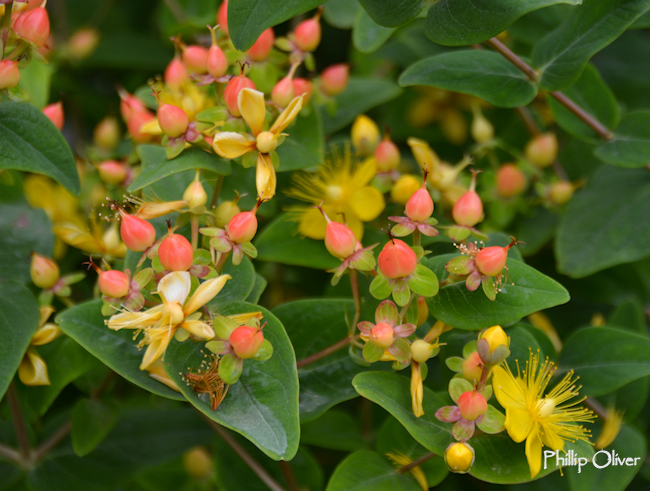One of the most dramatic and beautiful shrubs in the garden right now is the St. John's Wort 'Pumpkin' (Hypericum x inodorum). I say shrub but you might call it a perennial. Perhaps we should say it is a sub-shrub (but then, what exactly is that?)
The fact is, there are over 400 species of this plant and they range from groundcovers to larger-sized specimens like this one. A few blocks down the road, there is an impressive swath of the groundcover type that completely carpets the corner of the lawn and it is really beautiful when it blooms. When it is not in bloom, it looks very neat (although it did look much better before the house was sold and the elderly lady who lived there moved to northern Washington). I don't think the new owners are that much into gardening.
But back to the larger variety that we have - it is a hybrid between H. hircinum and H. androsaemum. Commonly called "toute saine" in French, it means "all healthy" or "all-heal", which refers to its medicinal value. In Australia, where is is native, it is considered a thug. Here in the Pacific Northwest, however, where it is much cooler, that does not seem to be a problem. At least, I have not noticed it getting out of hand here.
It is semi-evergreen or at least the leaves cling to the plant in winter although I would not say that they are green and beautiful. In very early spring, I pruned back about half of the stems down half-way to the ground. The other half, I tipped pruned. In just a few weeks, the plant took off and doubled in size. In our garden, it is well over 4 feet tall and as broad. It started blooming in late June.
The small yellow flowers that adorn the plant appear in clusters as well as singles. Beautiful stamens are included. At the same time, you have these lovely red berries. It is stunning I tell you, simply stunning! The flowers are excellent for arrangements.
And if that isn't enough to entice you, there is another incentive - the bees love it! It is continually abuzz with them.
There are many varieties floating around the nurseries. 'Pumpkin', also known as "Magical Pumpkin' or 'Kolmapuki', is just one selection. This variety is supposedly resistant to Puccinia rust.
Key Characteristics
Botanical Name - Hypericum x inodorum 'Pumpkin'
Common Name - St. John's Wort
Type: Small shrub
Foliage Type: Semi-evergreen
Size - 4-5' tall and wide
Bloom Time - June - October (Pacific Northwest)
Flower color - Yellow (red to orange berries)
Leaf color - Medium to light green
Exposure - Full sun to partial shade
Soil Needs - Average, moist soil
Growth Rate - Medium to Fast
Pruning - Cut back early in season before new growth begins
Hardiness - Zones 5-9
Pollinator Friendly: Yes
Deer Resistant - Yes
Drought Tolerant - Yes





I just planted the species St John's Wort this spring. I planted two of them. The rabbits ate one to death and the other down to a nubbin. It seems to be recovering nice. I hope that next year it will be half as big as yours. I think they are so pretty no matter what cultivar and like you say it is a pollinator magnet.
ReplyDeleteInteresting to know that rabbits eat it (supposedly deer don't). That is good to know.
DeleteThe flowers are beautiful, and indeed look even better combined with the berries. I didn't realize there was anything more than just the ground cover, which is to vigorous for my liking. The bush variety maybe better behaved; yours looks fantastic.
ReplyDeleteI've never seen that real plant here. I like the yellow flowers
ReplyDelete